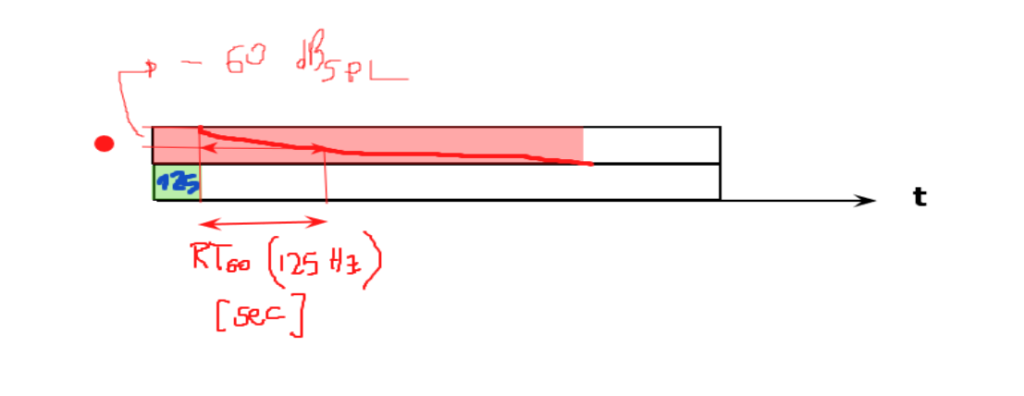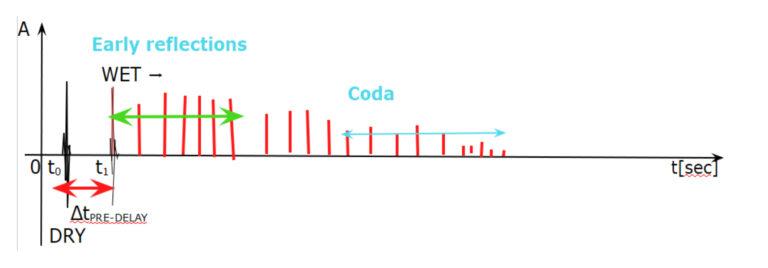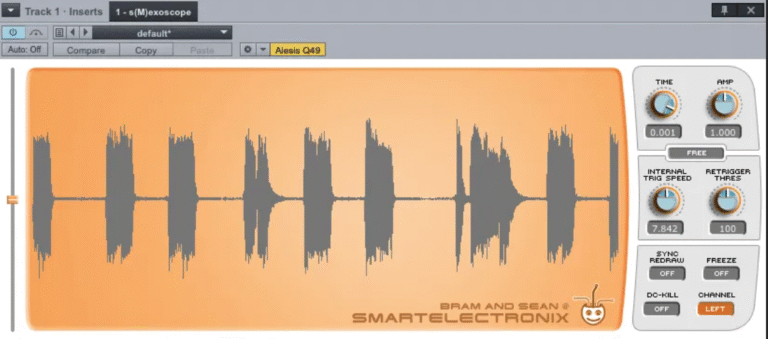Reverberation Time (RT60) is defined as the time it takes for the pure reverberation of a sound to decay by 60 dB SPL (Sound Pressure Level). It is a critical parameter in acoustics, providing insight into how sound behaves in a given space.
Key Parameters Influencing RT60
- Volume of the Room (V) [m³]: The total volume of the room significantly impacts RT60. The larger the volume, the longer the reverberation time is likely to be.
- Room Dimensions: The dimensions of the room, including length (X), width (Y), and height (Z), contribute to the distribution of volume across the three axes, affecting how sound waves interact with the space.
- Coordinates of Measurement: The spatial coordinates (x, y, z) of the point where RT60 is measured can influence the results due to variations in reflection and absorption properties throughout the room.
- Musical Style: Different musical genres require different reverberation times. For example, classical and symphonic music often benefits from longer reverberation, while genres like metal or electronic music may require shorter times for clarity and precision.
- Environmental Conditions: Factors such as temperature, pressure, and humidity can also affect RT60 measurements and sound propagation.
- Frequency Dependence: The reverberation time is frequency-dependent, with lower frequencies (LF) generally experiencing longer RT60 times than higher frequencies (HF). For example, 63 Hz is often referenced when measuring RT60.
Measuring RT60
To obtain an accurate RT60 measurement, it is essential to gather homogeneous values across various frequencies. The average RT60 is calculated by taking the RT60 at six specific frequencies: 125 Hz, 250 Hz, 500 Hz, 1 kHz, 2 kHz, and 4 kHz. The formula for the average is as follows:

The ideal RT60 for very large rooms can vary significantly compared to that for home studios, which should ideally be around 0.3 seconds for volumes less than 100 m³. It’s important to ensure that the values are close to the ideal average; for instance, if the average is 0.3 seconds, the individual measurements should range from 0.25 to 0.35 seconds, with slightly higher values in the LF range and lower in the HF range due to high damping.
Techniques for Measuring RT60
- Stationary Sources (Pink Noise): This method estimates the frequencies where reverberation is greater or lesser, providing qualitative measurements of RT60.
- Frequency Sweeps: Using a logarithmic sweep from 20 Hz to 20,000 Hz can help identify specific frequencies that are either attenuated or amplified by the room’s acoustics. This is typically done with a linear and omnidirectional microphone (like the Behringer ECM8000), allowing for more precise measurements of RT60 across specific frequencies.
- Sinusoidal Bursts: Short bursts of sound at specific frequencies (125 Hz, 250 Hz, 500 Hz, 1 kHz, 2 kHz, and 4 kHz) can also be used to measure RT60, focusing on the room’s response to these frequencies.

Conclusion
Understanding RT60 is crucial for optimizing acoustic environments, whether for recording studios, concert halls, or home listening spaces. By considering the various parameters that influence reverberation time and utilizing appropriate measurement techniques, sound engineers can create spaces that enhance audio clarity and overall listening experiences.
Feel free to adjust any sections or add additional details as needed!







Dear Itbblog,
I hope this message finds you well, though my heart is heavy as I write to you. Recently, I lost my beloved daughter to leukemia—a light in my life that was extinguished far too soon. She was a soul full of passion, and her greatest love was music. She dreamed of becoming a professional pianist, and her Yamaha piano was her most treasured possession. It was more than an instrument to her; it was an extension of her heart, her dreams, and her spirit.
Now, as I face my own battle with leukemia, I find myself reflecting on what matters most. I am in the process of preparing to join my parents, who have already passed, and my dear daughter. But before I go, I want to ensure that her piano finds a new home—a place where it can continue to bring joy, inspire creativity, and keep her legacy alive through music.
If you or someone you know shares her passion for music and would cherish this piano as she did, I would be deeply grateful. It would bring me peace to know that her dreams are still being carried forward, even as I prepare to say my own goodbyes.
Thank you for taking the time to read this. Your kindness and understanding mean more than words can express.
With warmth and hope,
Amanda
Dear Amanda,
I am deeply sorry to hear about the loss of your daughter and the painful journey you’re currently facing. The grief you’re experiencing is unimaginable, and my heart goes out to you.
It’s clear from your words how much love and meaning your daughter’s piano held for her, and I can feel the profound connection you share with her memory through the music she cherished. While words may never fully heal the pain, your daughter’s spirit will live on through the legacy of her passion for music.
I wish I could offer you more than words, but please know that your kindness in wanting to pass her treasured piano on to someone who will continue to honor her dreams speaks volumes. It is such a beautiful gesture, and I sincerely hope that it will find a home where it can bring as much joy and inspiration as it did for her.
If you would like, I can help spread the word and share this message with those who may be interested. Please don’t hesitate to reach out if you need any assistance.
Sending you warmth, comfort, and strength during this incredibly difficult time.
With deepest sympathy,
Endrin Sheen Hysa